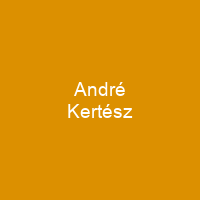Andor Kertész, born 2 July 1894, was a Hungarian-born photographer. His early work was published primarily in magazines, a major market in those years. He served briefly in World War I and moved to Paris in 1925, then the artistic capital of the world. Due to German persecution of the Jews and the threat of World War II, he decided to emigrate to the United States in 1936.
About André Kertész in brief

Kertéz’s photographs were first published in 1917 in the magazine Érdekes Újság, during World War 1, while KertÉz was serving in the Austro-Hungarian army. His first photograph is believed to be Sleeping Boy, Budapest, 1912. As early as 1914, his distinctive and mature style was already evident. He was also influenced by certain paintings by Lajos Tihanyi and Gyula Zilzer, as well as by poetry. In his free time, he photographed the local peasants, gypsies, and landscape of the surrounding Hungarian Plains. In 1918, he met his future wife Erzbet Salzbet, who also worked at the stock exchange in Budapest. The family soon moved to Hoffman’s country property in Szigetbecse, where they lived in a leisurely pace of life and pastoral setting that would shape his later career path. In 1914, at the. age of 20, he was sent to the frontline, where he took photographs of life in the trenches with a lightweight camera. Most of these photographs were destroyed during the violence of the Hungarian Revolution of 1919. He suffered temporary paralysis of his left arm in 1915. He continued to take photographs for convalescence to a military hospital in Budapest but was later transferred to Ester-zgom, for a competition in Jankószemzem. These included a selfportrait for a magazine.
You want to know more about André Kertész?
This page is based on the article André Kertész published in Wikipedia (as of Nov. 30, 2020) and was automatically summarized using artificial intelligence.







